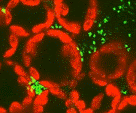Plant Pathology, Department of

Department of Plant Pathology: Faculty Publications
Document Type
Article
Date of this Version
4-12-2022
Citation
Mol Plant Pathol. 2022;23:1290–1302. DOI: 10.1111/mpp.13226
Abstract
In the devastating rice blast fungus Magnaporthe oryzae, six Magnaporthe appressoria-specific (MAS) proteins are encoded by MoGAS1, MoGAS2 and MoMAS3–MoMAS6. MoGAS1 and MoGAS2 were previously characterized as M. oryzae virulence factors; however, the roles of the other four genes are unknown. Here, we found that, although the loss of any MAS gene did not affect appressorial formation or vegetative growth, ΔMomas3 and ΔMomas5 mutant strains (but not the others) were reduced in virulence on susceptible CO-39 rice seedlings. Focusing on ΔMomas3 and ΔMomas5 mutant strains, we found that they could penetrate host leaf surfaces and fill the first infected rice cell but did not spread readily to neighbouring cells, suggesting they were impaired for biotrophic growth. Live-cell imaging of fluorescently labelled MoMas3 and MoMas5 proteins showed that during biotrophy, MoMas3 localized to the apoplastic compartment formed between fungal invasive hyphae and the plant-derived extra-invasive hyphal membrane while MoMas5 localized to the appressoria and the penetration peg. The loss of either MoMAS3 or MoMAS5 resulted in the accumulation of reactive oxygen species (ROS) in infected rice cells, resulting in the triggering of plant defences that inhibited mutant growth in planta. ΔMomas3 a nd ΔMomas5 biotrophic growth could be remediated by inhibiting host NADPH oxidases and suppressing ROS accumulation. Thus, MoMas3 and MoMas5 are novel virulence factors involved in suppressing host plant innate immunity to promote biotrophic growth.


Comments
Open Access